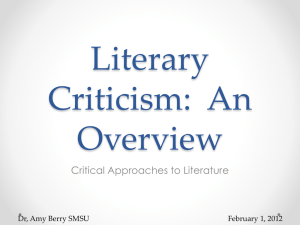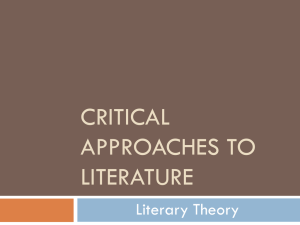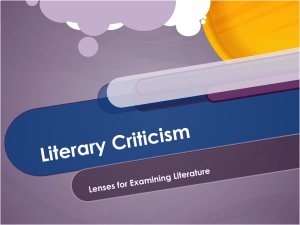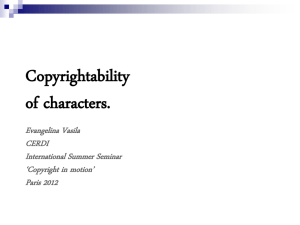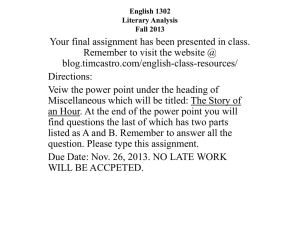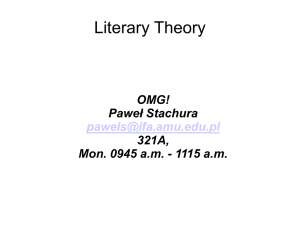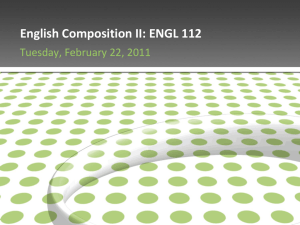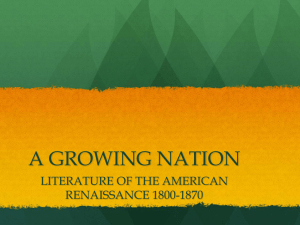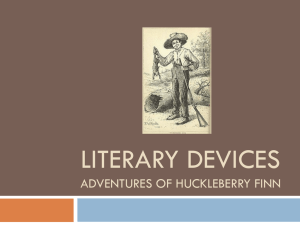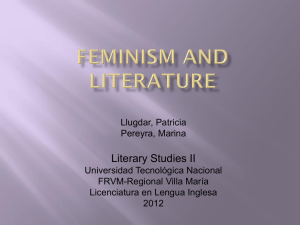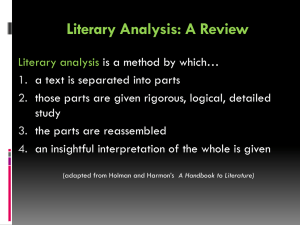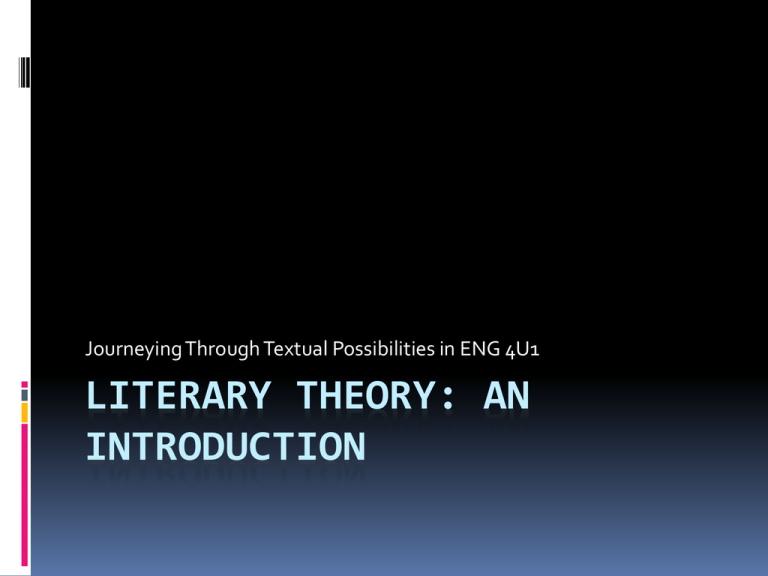
Journeying Through Textual Possibilities in ENG 4U1
LITERARY THEORY: AN
INTRODUCTION
Overview
1. What is Literary Theory?
2. Marxist Literary Theory
3. Feminist/Gender Criticism
4. Psychoanalytic Criticism
5. Historical Criticism
6. Modernism/Postmodernism
What is Literary Theory and
Criticism
We must rethink the relationship between
the author, the text, and the reader.
The reader plays an essential role in
interpreting a text.
As English students you primarily draw on
two modes of interpretation: (1) Your
personal and historical situation and
experience; (2) New Criticism- which you
have been taught in school.
Literary Theory and
Criticism
Literary Theory provides additional “lenses”
or conceptual frameworks for you to decode
and interpret a text differently.
Much of literary theory draws on different
philosophical, political, psychological and
social ways to interpret the world and our
thoughts.
Marxist Literary CriticismOrigins
Karl Marx (1818-1883) & Friederich Engels (1820-1895)
Both were German political philosophers, culture critics and
socio-economic theorists.
They co-authored the monumental work The Communist
Manifesto (1848).
Marx’s work Das Kapital (1867) revolutionized political theory
and politics itself by critically rethinking the effects of the
capitalist economic structure on individuals and
communities.
Their work became the foundation of Marxist-Communist
doctrine that was heavily drawn upon for Communist
revolutions of Russia (1917), China (1946-1952), and Cuba
(1962).
Marxism as A Literary Theory
It is important to note, that Marx did not intend
his political theory as simply a literary theory. His
goal was to use theory to change the social,
political and economic relations that we inhabit to
make them more just.
This being noted, if our artistic works, such as
fiction or even movies, are products of our culture,
reflect our culture, and reinforce practices, values
and beliefs of our capitalist culture, it follows that
Marxist theory can provide interpretative insight
into said literature.
Marxism: The Fundamentals
Humans and societies are fundamentally defined by the socio
economic structure they inhabit.
Marx introduced the concept of dialectical materialism; the idea
that human communities are fundamentally defined by material
economic forces of their society which progresses through
efficiency.
Here is the catch: Each economic system grows more efficient but
has internal contradictions and problems the lead to its downfall.
Eventually each society inevitably collapses because of these
contradictions, and is replaced with a more productive and
efficient system.
This process comes to an end with the emergence of Communism.
MercantalismFeudalismCapatilismCommunism
Marx and Capitalism:
Troubling our Blissful
Materialistic
Capitalism inevitably rests
on the unmanageable
Waters
foundation of vast economic disparities between
classes being both necessary and sustainable.
Marx argues that this inevitably leads to class
conflict between the bourgeoisie (the owner’s of
businesses and factories) and the proletariat
(workers).
This class structure and conflict has inevitably
influenced our ideology (ideas, values, and
beliefs).
Some Problems
Problem One: Class Conflict
The bourgeoisie‘s goal is to always maximize
profit. As a consequence, they fundamentally
exploit the proletariat.
Without resistance, the bourgeoisie will always try
to pay the proletariat the minimum salary.
The bourgeoisie will also begin to view the
workers as another object of production. The
workers begin to be thought of as another
“appendage of a machine.”
A person becomes the nothing more than the
value of his or her labour.
More Problems
Problem Two: Commodification
Everything in the capitalist system becomes a
commodity-something that can be bought
and sold for the benefit of the bourgeois.
People=$
Love=$
Sex=$
Relationships=$
Education=$
More Problems: Ugh.
Problem Three: Alienation
Marx argues that people are necessarily
drawn to work as a fundamental part of their
being human.
Example- Building a table
In the capitalist system, workers become
alienated to their work, the products and the
means of production.
This problem is compounded insofar as
workers are often treated poorly by the
More Problems: Double Ugh
Problem Four: False consciousness
According to Marx, because we are born, live, and breath
the capitalist system we fail to see these negative
effects. Simply put, economic and political system
constructs our reality.
As a result, we fail to see the fact that they are not
“natural.” Specifically, that humans can create and
recreate their social, economic and political system
Ideally this recreation would take the form of
Communism for Marx.
Key Questions for a Marxist
Interpretation
(1) Does the text rest on the ideology (beliefs, values and
practices) of the capitalist system?
(2) Are there conflicts between classes within the text?
What unequal power structures exist between people in
the text?
(3) Are the poor and working class alienated and harmed in
the text? Do the poor try to resist or overcome this
oppression?
(4) Does the text support or challenge the status quo?
(Characters, narration etc.)
(5) Is there a sense of false consciousness in characters in
the text? By the author himself or herself?
Next Step
As you ask these fundamental questions, you use your
previous knowledge of literary interpretation to flush out
the key elements of the text.
Protagonist/Antagonist- Bourgeois? Proletariat?
Conflicts- Person vs Society (Class?), Person vs
Self(Alienation? Guilt?)
Symbolism- How do they relate to class conflict,
alienation, false consciousness etc.?
Setting-the socio-political structure the characters are
situated in?
Quick Case Study: Cinderella
Cinderella exploited by her more wealthy
step-sisters.
The step sisters and Cinderella long to marry
a rich prince
The prince controls the kingdom and can
choose whomever he wants to marry him.
The End (Disney Version): Cinderella marries
the prince and lives happily ever after.
Bucket Rider: A Marxist
Interpretation
(1) Read Kafka’s short story “The Bucket Rider”.
(2) Provide a Marxist interpretation of the text
by answering the aforementioned questions.
(3) Additionally, drawing on your previous
understanding of literary and figurative
devices, analyze the major literary features
of this text through a Marxist lense.
Feminist Literary Criticism
Emerged from the Feminist social and political
movement.
In the most narrow sense, the feminist movement
attempts to “attain equal legal and political rights for
women” (Hendrich 1995).
In the most general sense, feminist theory attempts to
understand and critique the relationship between sexes
within society.
Included in this critical analysis is the interrogation of
inequities, subordination and various forms of
oppression that are experienced by women.
Feminist Theory: A Brief
History
The First Wave (1750s to 1900s)
Early work highlighted the differences
between sexes.
Also began to challenge the doctrine of
separate spheres.
The first wave of feminist movement was
marked by the suffrage movement at the turn
of the century.
Key early works: Mary Wollenstonecraft’s work A Vindication
of Rights of Women (1792) and John Stuart Mill’s
Feminism: A Brief History
Second Wave (1940s to 1980s)
Extended and deepened feminist critique with particular
emphasis on the role of women in the workplace.
The emergence of feminist political activist.
Questioning of the dominant influence of the masculine
perspective in culture, the economy, and politics.
Attempts to rediscover and recognize female writers.
Writers: Simone De Beauvoir, Elain Showalter.
Feminism: A Brief History
Third Wave (1980s-?)
Fundamentally challenging and rejecting the “essentialism” (any
form of over-generalization) of the masculine and feminine
categories.
Critique of Western society’s “glass ceiling” for women. Particularly,
the view that some equality had been achieved but not full equality.
Also a fundamental rethinking of the nuance differences in race and
genders.
During this time, the is the emergence of gender criticism. The
questioning of the nuance differences within the category of
“gender.”
Key Writers: bell hooks, Amelia Jones, Judith Butler among many others
Feminism: Understanding and
Challenging Social
Men traditionally associated with reason, the
Stereotypes
workplace, decisiveness and power.
Females traditionally associated with the
emotions, the home, nurturing and
submissiveness.
These traits are reinforced by the idea of
biological essentialism- the view that these
traits are necessarily built into each gender
category.
Example: Princeton Dean Larry
Summers on why women are not in
science
andto engineering
“So my best guess,
provoke you, of what’s behind all of
this is that the largest phenomenon, by far, is the general
programs
clash between people’s legitimate family desires and
employers’ current desire for high power and high
intensity, that in the special case of science and
engineering, there are issues of intrinsic aptitude, and
particularly of the variability of aptitude, and that those
considerations are reinforced by what in fact are lesser
factors involving socialization and continuing
discrimination.” -2005 Conference of Diversifying the
Science Engineering Workforce.
Feminism as a Literary
Theory
Three very general overarching goals are at the foundation
of feminist literary theory:
(1) Rediscovering, recognizing and celebrating female
writers and intellectuals.
(2) Critically analyzing literary works and questioning how
women are (mis)understood, stereotyped and often
oppressed.
(3) Challenging these stereotypes through literature and
writing from a feminist perspective.
Fundamental Questions
How is the relationship between men and women portrayed? Do the
relationships reinforce gender inequalities and stereotypes or do they
challenge them?
What are the power relationships between men and women (or characters
assuming male/female roles)?
How are male and female roles defined?
What constitutes masculinity and femininity?
How do characters embody these traits?
Do characters take on traits from opposite genders? How so? How does this
change others’ reactions to them?
What does the work reveal about the operations (economically, politically,
socially, or psychologically) of patriarchy?
Source: http://owl.english.purdue.edu
A Feminist Interpretation:
“The Yellow Wallpaper”
Read Charlotte Perkins Gilman’s short story
“The Yellow Wallpaper” (1892).
Apply the feminist interpretative questions to
your work.
Concurrently, drawing on your previous
understanding of literary and figurative
devices, analyze the major literary features of
this text through a Feminist framework.
Psychoanalytic Literary
Criticism
Literary theory that draws on psychoanalytic
analysis popularized by Sigmund Freud
starting in the 1930s.
Primary focus is on the conscious and the
unconscious mind.
Particular importance is placed on
interpreting the latent meaning behind and
author’s writing using psychoanalytic
analysis.
Sigmund Freud: What’s in
Your Subconcious?
Freud (1856-1939) is the founder of the psychoanalytic
school of psychological analysis.
Psychoanalysis primary focuses is trying to understand
analyze conscious, unconscious mind as well as the
relationship between the two.
Freud believes in the notion of the unconscious has a
strong influence upon our actions.
Central to his analysis, is using his psychoanalytic theory
to interpret dreams.
A Tale of Childhood
Repression
Freud believed that our unconscious was influenced by childhood
events.
Freud organized these events into developmental stages involving
relationships with parents and drives of desire and pleasure where
children focus "...on different parts of the body...starting with the
mouth...shifting to the oral, anal, and phallic phases..." (Richter
1015).
These stages reflect base levels of desire, but they also involve fear
of loss (loss of genitals, loss of affection from parents, loss of life)
and repression: "...the expunging from consciousness of these
unhappy psychological events" (Tyson 15).
Central to Freud’s view is that we often repress these unconscious
desire and/or we sublimate them (we project our insecurities, fears
and desires on the external world).
Being Conscious of
Consciousness and
Freud maintained that our desires and our unconscious conflicts give
Unconsciousness
rise to three areas of the mind that wrestle for dominance as we
grow from infancy, to childhood, to adulthood:
id - "...the location of the drives" or libido.
superego - the area of the unconscious that houses judgement (of
self and others). The superego is made of two parts: our conscience
and our ego-ideal.
ego - the thinking part of both id and superego. Conscious
awareness resides in the ego, and we use to the ego to reveal
ourselves to the world.
Oedipus Complex
Essentially, the Oedipus complex involves children's need for their parents
and the conflict that arises as children mature and realize they are not the
absolute focus of their mother's attention: "the Oedipus complex begins in a
late phase of infantile sexuality, between the child's third and sixth year, and
it takes a different form in males than it does in females" (Richter 1016).
Freud argued that both boys and girls wish to possess their mothers, but as
they grow older "...they begin to sense that their claim to exclusive attention
is thwarted by the mother's attention to the father..." (Richter 1016).
Children, Freud maintained, connect this conflict of attention to the
intimate relations between mother and father, relations from which the
children are excluded. Freud believed that "the result is a murderous rage
against the father...and a desire to possess the mother
Freudian Questions
How do the operations of repression and/or sublimation inform the work?
(Example: Guilt, desire, anger etc.)
What is the relationship between the characters id, superego, and ego?
Are there any oedipal dynamics - or any other family dynamics - are work
here?
How can characters' behavior, narrative events, and/or images be explained
in terms of psychoanalytic concepts of any kind (for example...fear or
fascination with death, sexuality)
What might a given interpretation of a literary work suggest about the
psychological motives of the author or even reader?
Are there prominent words in the piece that could have different or hidden
meanings? Could there be a subconscious reason for the author using these
"problem words"?
Carl Jung (1875-1961)
Jungian criticism attempts to explore the connection between
literature and what Carl Jung (a student of Freud) called the
“collective unconscious” of the human race.
Jung’s main criticism of Freud is that every desire and fear in our
unconscious is rooted in sexuality.
The ultimate goal for Jungians is perfect unity of the conscious and
unconscious through understanding the self as well as the external
world.
Jungian criticism, closely related to Freudian theory because of its
connection to psychoanalysis, assumes that all stories and symbols
are based on mythic models from humanity’s past.
In literary analysis, a Jungian critic would look for archetypes in
creative works.
Common Archetypes
The self-the unification of unconsciousness and consciousness. Not just “me” but
connection to what Lacan called the “real” or even God. Often represented by a circle.
The shadow- repressed ideas, desires, instincts etc.
The persona- Various literal and figurative social masks that people wear.
Anima-Feminine inner personality/Animus- masculine inner personality.
The father-authority figure and powerful
The mother-nurturing and comforting
The child-innocence
The wise old man- wisdom and guidance
The hero-champion and defender
The maiden-innocence, purity and desire
The trickster- deceiver, liar and trouble maker
Jungian Questions
What connections can we make between elements of the text and the
archetypes? (Mask, Shadow, Anima, Animus)
How do the characters in the text mirror the archetypal figures? (Great
Mother or nurturing Mother, Wise Old Man, Shadowy figure)
How symbolic is the imagery in the work? How does each symbol interact
with one another?
How does the protagonist reflect the hero of myth?
Does the “hero” embark on a journey in either a physical or spiritual sense?
Is there a journey to an underworld or land of the dead?
What trials or ordeals does the protagonist face? What is the reward for
overcoming them?
A Return to “The Yellow
Wallpaper”
Let us apply psychoanalytic analysis to
Gillman’s short story.
Using the questions provided, analyze the
story using the Freudian and Jungian
framework.
Edgar Allen Poe: “A Tell
Tale Heart”
Poe (1809-1849) was a pioneer Gothic writer
that opened up the genre of the modern
“horror story.”
Many of his work deal with the psychological
nuances of the human mind. Specifically, with
people’s fears, desires and guilt.
Read “A Tell Tale Heart” and apply the
psychoanalytic framework to the best of your
ability. Finally, return to your literary analysis
framework and begin asking interpretive
Historical Criticism
Quite unsurprisingly, historical criticism focuses on social, cultural
and political era of the work in question.
Through understanding the historical context of the story itself as
well as the author, we can, in turn, provide fresh insight into the text
itself.
Historical criticism works under the assumption that a literary work
is very much a reflection of the historical era in which it was created.
Important note: With historical criticism you are analyzing the work
itself as a reflection of the times. You, however, are not necessarily
analyzing the setting of the story. Ex. Science Fiction
Historical Criticism is eventually supplanted by New Historical
Criticism (See postmodernism)
Historical Criticism: Key
Elements
What is the political climate and ideology of the work?
What is the particular culture that the work is a reflection of?
The historical language used in the story? How doe this language
reflect the historical period it is situated in?
What is the form of the work? Is it reflective of a particular historical
period?
What particular historical events, tensions, and issues that are
reflective in the work.
What is the author’s background?
John Updike Analysis: “A &
P” Historical Context of the short story.
The 1960s, USA.
The Cold-War.
The emergence of the baby-boom generation.
Emergence of the counterculture movement: Anti-
consumerism, anti-government, anti-authority, anti-tradition.
The counter culture movement was reflected in political
protests, popular culture, and the arts.
Concurrently, there was resentment among older generations at
the loss of tradition.
Updike
Using the brief historical sketch that I
provided, examine his short story as a
reflection of the time.
As per usual, answer the historical based
questions to get your “lens” working, and
then begin analyzing the literary elements of
the work.
Postmodernism:____________?
Essential to understanding Post-modernism, is
understanding modernism.
Modernist philosophers, intellectuals, and academics
generally believe that we can come to an understand (in
the strong sense) and know the world (in the strong
sense).
Example: Science and Math- A₂ + B₂= C₂
Example: Literature- We can come to know in through To
Kill A Mockingbird that Harper Lee rejects racism, and she
thinks empathy is an essential moral way of combating
prejudice.
Postmodernism
At its most fundamental level, postmodernist are
sceptical and generally reject the idea that there is any
one form of understanding, knowledge or sense of Truth.
Simply put, language cannot convey truth and robust
understanding of the world to the audience.
Consequently, the Postmodern theorists ultimately show
the plurality of meaning(s), understanding(s), and
truth(s) inherent within our perception of the world and
texts.
Postmodernism-Name Dropping so we can feel
Academic like. (Fictional quotes provided by
your teacher)
Soren Kierkengaard (1813-1855) :”Hate to break it to you, but the world does not
make any sense. We are faced with decisions, indecisions, commitments, lack of
commitments, life, death and dilemmas with no answers...just embrace the absurd
and the make the leap of faith to God.”
Friederich Nietzsche (1855-1900)- “Hey everyone, did you hear that god died,
Christianity is a slave morality, and that special individuals should create their own
value systems (Superman Rules)?”
Jean-Paul Sartre (1905-1980):” Ole Superman is right. There is no meaning in the
world without humans. We each have to create our own meaning-we exist as free
individuals who can define our own essences.”
Michel Foucault (1926-1984): “Good point Sarty...but why did you return to Marxism
then? Give it up-there is no singular Truth. All we have is power and different
perspectives on truth. Society constructs madness, sexuality , politics, and ‘truth’ .
Let us just look at how these constructions are developed and made...now that is an
exciting Friday night, No?”
Jacques Derrida (1930-2004): “Hey Michel ! Friday is good for me. Bring over some
texts and we deconstruct some of them to show a plurality of meanings as well as the
bias inherent in the language we use”
A Note on Postmodernist
Writing
Postmodern writers are the constructive
counterpart to the deconstructive theorists.
Post-Mo literature attempts to defy
traditional narrative conventions. Ex.
Fragmented or tangential storylines, obscure
and opaque text, complex identities of the
characters.
They capture the fragmentation and lack of
unity of the postmodern condition.
Key Element of PM Literary
Theory: Hermeneutics
Embracing multiple interpretations of texts.
Hans Gadamer, a German philosopher and linguist,
argued hermeneutic’s (or the interpretation of texts) goal
“is not to discover the ‘one meaning’ of the text. The
meaning of the text is not that strictly circumscribed: the
limits of a text’s meaning are not confined to just the
author’s intent or the reader’s understanding. In fact, we
can never claim that any one interpretation is correct ‘in
itself.’”
Key Element Related to the Last Key
Element: Author intent
For postmodernist literary theorist, we should
move beyond trying to understand what the
author intended by the text itself.
Postmodernist argue that even if the author
clearly explains himself or herself, that we, as
readers, can never really understand his or
her intent. As such, there is an irrevocable
chasm between the reader and the audience.
All we have, then, is our personal and
subjective experience of the text itself.
Key Element III: No mo BIG
narratives
Philosopher Jean-Francois Lyotard wrote that the
Postmodern condition meant that as readers and
interpreters of text, we can no longer believe in grand
narratives to trust our interpretation of the works and the
world.
Ex. Christianity
Ex. Marxism
Ex. Freudian Psychoanalysis
All we are left with is embracing mini-narratives,
including our own, and deconstructing texts.
Key Element IV:
Deconstruction
Coined by philosopher Jacques Derrida.
A postmodern methodology that is employed to destabilize a text to
unearth plurality of meanings.
Often in writing we use binary divisions to make our point: Example-
Absence/Presence, Good/Evil, Normal/Abnormal.
He argues that if you begin analyzing these divisions that one is
often times privileged at the expense of its binary opposite.
Moreover, he argues that these divisions also leave out particular
nuances of human experiences.
Derrida reveals these division and challenges their legitimacy
through deconstruction.
Ex. Writing vs Speaking
Key PM Questions
How does the work undermine or contradict generally accepted truths?
How does the author (or a character) omit, change, or reconstruct memory
and identity?
How does a work fulfill or move outside the established conventions of its
genre?
How does the work deal with the separation (or lack thereof) between
writer, work, and reader?
What ideology does the text seem to promote? How are their contradictions
and even tensions within this narrative?
What is left out of the text that if included might undermine the goal of the
work?
If we changed the point of view of the text - say from one character to
another, or multiple characters - how would the story change? Whose story
is not told in the text? Who is left out and why might the author have
omitted this character's tale?


